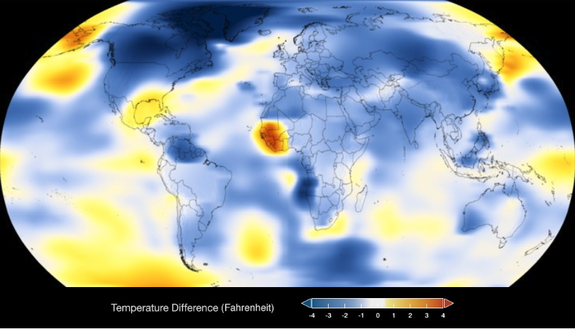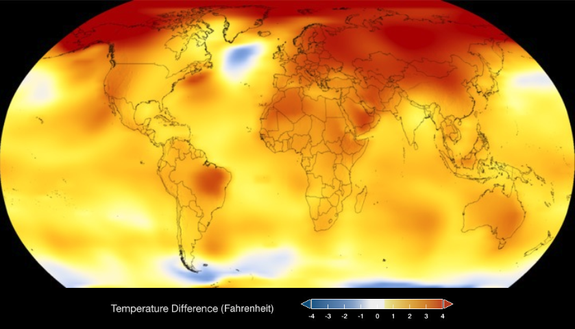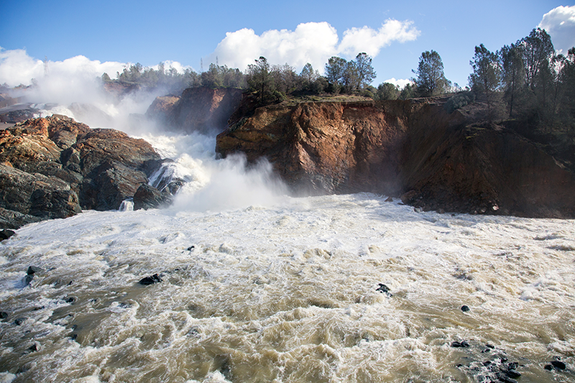Climate change made these 17 extreme weather events radically worse

Just as scientists confidently predicted last century, climate change is pushing weather to extremes all over the planet.
A new report, published Monday by the American Meteorological Society, again proves the point. The 100-page report assessed 17 extreme weather events from 2017 — including floods, droughts, and heat waves — and determined global warming either significantly boosted the odds of these events, or simply made such extreme, often deadly events possible in the first place.
"We are in a world that is warmer than in the 20th Century, and we keep moving farther from that baseline," Martin Hoerling, a National Oceanic and Atmospheric Administration (NOAA) scientist who worked on the report, said at the 2018 American Geophysical Union conference on Monday.
"There are very few places escaping from the warming that is occurring on our planet today," Hoerling added.

Image: nasa

Image: nasa
For each extreme event, the report outlines just how much climate change increased its likelihood, which is a growing field of science known as attribution research.
And when it comes to heat waves, rain, and drought, scientists have a good handle on how climate change exacerbates these events, often by modeling the chances of extreme weather events in the absence of today's globally disrupted climate.
"These attribution studies are telling us that a warming Earth is continuing to send us new and more extreme weather events every year,” Jeff Rosenfeld, editor in chief of the Bulletin of the American Meteorological Society, said in a statement.
Extreme deluges
Of note, Earth's hydrological, or water systems, have been propelled to the extreme. One reason is simple: Warming temperatures mean more water vapor is loaded into the atmosphere. Specifically for every 1 degree Celsius (1.8 degrees Fahrenheit) of warming, the air can hold 7 percent more water. That can mean historic, prolonged deluges.

Image: Dale Kolke/ California Department of Water Resources
In the U.S., scientists pointed out deluges during the 2017 California winter that threatened to collapse the state's largest reservoir (the Oroville Dam), and the most extreme rain event in the nation's history, Hurricane Harvey.
"No single storm (Oroville) or instantaneous precipitation rate (Harvey) was to blame; rather, the damages were caused by precipitation that did not seem to stop," the authors wrote.
The report also highlights severe 2017 flooding in Bangladesh, Peru and China.
In Bangladesh, for example, extreme rain fell for six straight days before the expected monsoon, or summer rainfall season, even began. Human-caused warming, the authors found, was 100 percent responsible for the unusual rainfall event.
Heavy precipitation is becoming more intense and more frequent across most of the United States, particularly in the Northeast and Midwest. https://t.co/6t6uJmxvcS #climateindicators pic.twitter.com/K8Tzgns5eT
— globalchange.gov (@usgcrp) November 27, 2018
Heat, heat, heat
Heat waves, the number one natural killer of humans, made a strong appearance in 2017 (and then again in 2018).
Since the onset of the Industrial Revolution in the mid-1800s, climate change has boosted the average global temperature by 1.8 degrees Fahrenheit, or 1 degree Celsius. This background warming makes typical heat waves all the more extreme, resulting in record heat.
"I’m virtually certain that nearly all heat waves have been made more severe by climate change," Michael Wehner, a senior scientist at the U.S. Department of Energy's Lawrence Berkeley National Laboratory, said this summer amid a flurry of global heat waves.
SEE ALSO: Smokey Bear's world is on fire. But the old mascot won't die.
In 2017, southern Europe experienced an "exceptional heat wave" which was nicknamed "Lucifer." Temperatures in the Balkans and Italy sustained in the triple-digits for days, records fell, and nighttime temperatures elsewhere exceeded over 85 degrees.
Such a scorcher is three times more likely than it was in more temperate 1950s, the authors conclude.
And while Europe burned, China did the same.
The northeastern portion of the country saw its hottest temperatures on record, as a sustained mass of warm air hovered over the vast region.
"The key thing to remember about the report is that it’s clear that the best time to have reduced emissions was 25 years ago, but the second best time to reduce emissions is right now.” — Gavin Schmidt on the recent @IPCC_CH report. https://t.co/AyZtW605lI pic.twitter.com/8w5oCfZtMZ
— NASA Earth (@NASAEarth) October 19, 2018
The authors concluded that climate change, all the more enhanced by decreasing Arctic sea ice (which ultimately helped produce this block of warm air), were the environmental culprits.
While once rare, severe heat events in this part of China are now believed to have a one in five chance of happening during any given year.
Paralyzing Drought
A particularly harsh drought hit the Northern Great Plains of the U.S. in 2017 — even threatening an essential ingredient in beer.
This event, which proved to be a billion dollar disaster, hit Americans with a double whammy. Hot temperatures dried out the soil, easily outpacing dismal, record-low rains.
After modeling different climate scenarios, researchers determined that this event was 1.5 times more likely under our current climate scenario, wherein the atmosphere is saturated with its highest levels of carbon dioxide in some 15 million years.
WATCH: A scientist claims to have made the world's first gene-edited babies — Sharp Science


